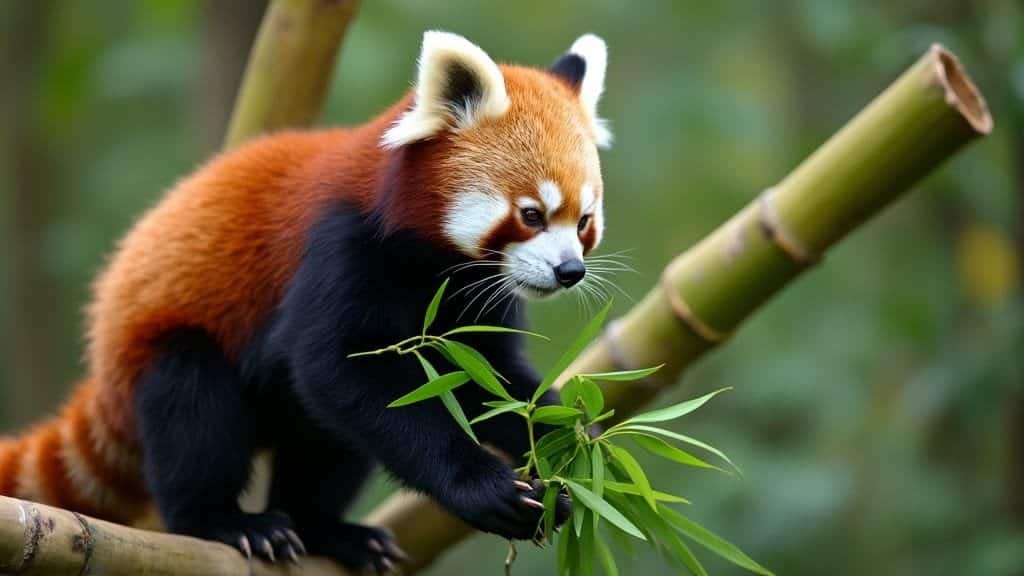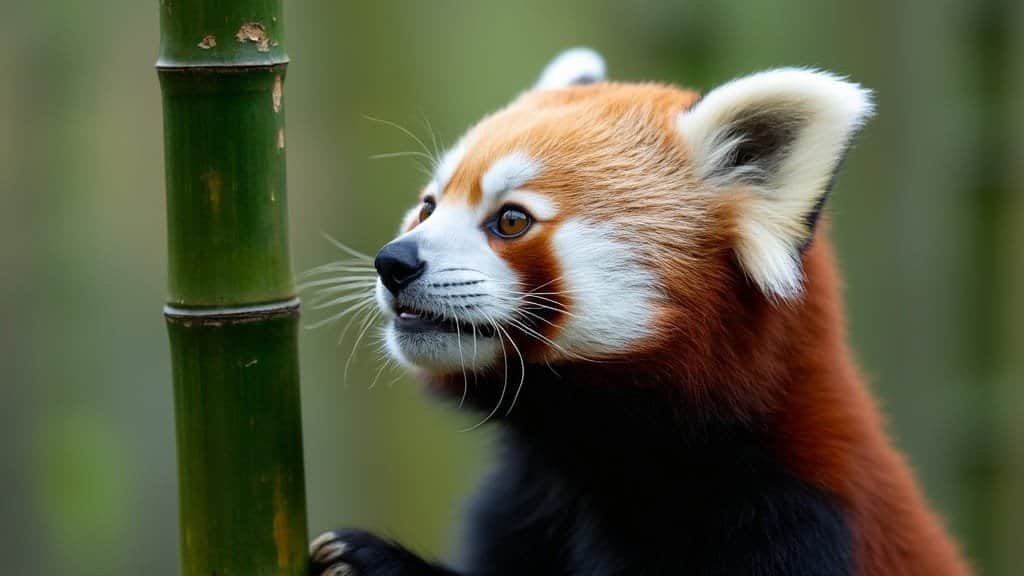Red pandas are picky eaters, carefully selecting the most nutritious and digestible parts of bamboo to survive on their fiber-heavy diet. Despite bamboo making up 85-95% of their food intake, not all parts of the plant provide equal nutritional value. Red pandas instinctively choose bamboo shoots and young leaves, which are higher in protein and water, while avoiding mature leaves and stems, which are tougher and harder to digest
The process of selecting bamboo involves multiple factors, including nutrient content, fiber levels, moisture availability, and seasonal changes. Bamboo species vary in protein and digestibility, influencing which plants red pandas prefer to eat. Their sensitive sense of smell and taste helps them detect the freshest, most energy-rich bamboo, ensuring they get the most nutrients from their diet. However, as seasons change and bamboo quality declines, red pandas must adjust their feeding habits, increasing their eating time in winter to compensate for the lower nutritional value of available bamboo.
This article explores how red pandas decide which parts of bamboo to eat, the physical and sensory adaptations that help them choose food, and the challenges they face due to habitat loss and seasonal bamboo shortages
Factors Influencing Red Panda Bamboo Selection

Red pandas do not eat bamboo at random; they carefully select the most nutrient-rich and digestible parts to maximize their energy intake. Their food choices are influenced by nutritional content, fiber levels, water availability, and seasonal changes, all of which play a role in determining which parts of the plant they consume
Nutritional Content and Seasonal Availability
The nutritional value of bamboo changes throughout the year, directly affecting red panda feeding behavior. In spring and early summer, bamboo shoots emerge, offering the highest protein content (6-8%) and the most moisture (75-80%), making them the most preferred food source. These shoots are easy to digest, requiring less energy to process while providing a rich source of nutrients
As summer progresses into fall, bamboo shoots become less available, and red pandas switch to young leaves, which still contain moderate protein levels but more fiber. While less nutritious than shoots, these leaves are softer and easier to break down than mature leaves. By late fall and winter, red pandas are left with mature bamboo leaves and stems, which are low in protein (<3%) and extremely fibrous (35-40%), making digestion much more difficult
Because their digestive system is inefficient, red pandas must spend more time eating in winter, increasing their food intake to compensate for the lower nutritional value of available bamboo (Red Pandazine, 2016)
The Role of Fiber and Digestibility in Food Choices
Bamboo is high in fiber, but not all fiber is the same. Red pandas prefer bamboo parts that contain less lignin, a rigid plant compound that makes digestion more difficult. Younger bamboo leaves and shoots contain less lignin and more digestible fiber, allowing red pandas to extract more energy from each meal. In contrast, mature leaves and stalks have higher fiber content and take more energy to process than they provide, making them less desirable
Because red pandas have a simple stomach and a short digestive tract, they lack the ability to ferment fiber efficiently, unlike herbivores such as deer or cattle. Instead, their gut bacteria help break down some cellulose, but digestion remains rapid and incomplete. To cope with this inefficiency, red pandas select bamboo parts that provide the most energy with the least digestive effort (San Diego Zoo)
How Moisture Levels Affect Bamboo Preference
Water content plays a key role in red panda food selection. Unlike many animals that rely on lakes or streams for hydration, red pandas obtain most of their water from food, making bamboo a primary hydration source. Bamboo shoots and young leaves contain higher moisture levels (60-80%), reducing the need for red pandas to seek additional water sources
In winter, bamboo becomes drier and more fibrous, increasing red pandas’ feeding time and food intake to maintain hydration. Studies show that red pandas will choose bamboo species with higher water content whenever possible, helping them stay hydrated without expending energy searching for fresh water (Medium, 2022)
For further insights on how nutrition and digestibility affect red panda food choices, visit the Red Pandazine article on bamboo selection
Physical and Sensory Adaptations for Selecting Bamboo

Red pandas do not randomly consume bamboo; they rely on specialized physical features and sensory abilities to detect, assess, and process the most nutrient-rich and digestible parts of the plant. Their keen sense of smell, strong molars, and powerful jaw muscles all play essential roles in helping them choose the best food sources while avoiding tough, fibrous plant material that provides little nutritional value
The Role of Smell and Taste in Food Selection
Red pandas use their highly developed sense of smell to detect the freshest, most nutritious bamboo parts. Their olfactory receptors help them differentiate between young and mature bamboo leaves, allowing them to instinctively select the most energy-rich parts of the plant. This ability is especially useful when bamboo species grow in dense clusters, where red pandas must quickly determine which stalks provide the highest nutritional value
In addition to smell, red pandas rely on their taste receptors to assess fiber content. Their tongue and inner cheeks contain specialized nerve endings that allow them to detect the moisture and toughness of bamboo leaves, helping them decide whether a leaf is worth eating or should be discarded. Unlike some herbivores that indiscriminately consume large amounts of plant material, red pandas are highly selective feeders, avoiding bamboo that is too dry or difficult to digest (San Diego Zoo, 2022)
Teeth and Jaw Adaptations for Assessing Bamboo Toughness
Because bamboo is fibrous and rigid, red pandas need specialized teeth and jaw muscles to process it effectively. Their large, ridged molars are designed to grind down tough bamboo fibers, breaking them into smaller, more digestible pieces before ingestion. Unlike carnivores, which have sharp teeth for tearing meat, red pandas have flat, crushing molars that function like natural grinders, reducing bamboo into a manageable texture for digestion
Their jaw structure is uniquely adapted for prolonged chewing, featuring a powerful masseter muscle that provides the necessary force to break down plant fibers. This adaptation is crucial, as red pandas spend up to 13 hours per day chewing bamboo, requiring a jaw system that resists wear and fatigue. Without this adaptation, they would struggle to process enough food to meet their energy needs (Red Pandazine, 2016)
How Red Pandas Identify the Most Energy-Rich Bamboo Parts
Red pandas exhibit distinct feeding behaviors that help them identify the most nutrient-dense bamboo available. When foraging, they will often sniff and nibble bamboo leaves before fully consuming them, testing the plant’s moisture content, texture, and taste. If a particular leaf or stalk is too fibrous or lacks sufficient hydration, they will discard it and move on to another plant
Observations of wild red pandas have shown that they often prioritize bamboo species with higher protein and lower fiber content, suggesting an innate ability to detect energy-rich plants. Studies by Wei et al. (Mammal Research, 2017) confirm that red pandas select bamboo with higher nitrogen levels, a sign of better nutritional quality. This strategic feeding behavior ensures that red pandas maximize energy intake while minimizing digestive effort, helping them survive on an otherwise low-nutrient diet
For more details on how red pandas use their physical adaptations to select bamboo, visit the Medium article on red panda feeding habits
Seasonal Changes in Bamboo Consumption

Red pandas do not eat the same bamboo parts year-round. Their diet shifts with seasonal availability, forcing them to adjust their feeding behavior based on the nutritional value and digestibility of the bamboo parts available. These changes influence not only their food choices but also their feeding time and energy expenditure throughout the year
Preference for Shoots in Spring and Summer
Spring and early summer provide the most nutritious and digestible bamboo parts—tender shoots. These young, rapidly growing sprouts contain the highest protein content (6-8%) and water levels (75-80%), making them the preferred food source for red pandas. Because bamboo shoots are softer and easier to break down, red pandas can consume them more efficiently while extracting more nutrients per bite
During this season, red pandas spend less time eating compared to winter, as the energy density of bamboo shoots is higher. Research from San Diego Zoo (2022) shows that red pandas prioritize moist, high-protein shoots, which help them build fat reserves in preparation for colder months
Transition to Young Leaves in Fall
As summer progresses into fall, bamboo shoots become scarce, forcing red pandas to transition to young leaves, which contain moderate protein levels but more fiber. These leaves are not as energy-rich as shoots, but they are still easier to digest than mature leaves and stems
During this period, red pandas increase their feeding time slightly, as they need to eat larger quantities to extract the same amount of energy they received from shoots in the spring. Observations of wild red pandas have shown that they select bamboo species with higher nitrogen content, ensuring they obtain as much protein as possible before winter (Red Pandazine, 2016)
Increased Feeding Time in Winter Due to Low-Quality Bamboo
Winter presents the biggest dietary challenge for red pandas, as they must rely on mature bamboo leaves and stems, which are low in protein and high in fiber. These plant parts are tougher to chew and harder to digest, forcing red pandas to spend more time eating to compensate for the lower energy intake
During winter, red pandas can spend up to 13 hours per day foraging and feeding, nearly 20% more time than in warmer months. This increase in feeding time is necessary to maintain their energy levels, as the bamboo parts available provide little nutritional value. Additionally, red pandas lower their metabolic rate to conserve energy, helping them survive despite the poor-quality diet
A study by Wei et al. (Mammal Research, 2017) found that red pandas adjust their diet based on bamboo quality, environmental conditions, and competition for food, demonstrating their ability to adapt their feeding habits as needed. However, habitat loss and climate change threaten bamboo forests, making these seasonal adjustments increasingly difficult
For more insights into how red pandas change their feeding habits throughout the year, visit the San Diego Zoo article on red panda diet













